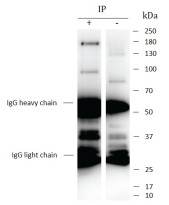ARG44687
anti-KDM3A antibody
anti-KDM3A antibody for Immunoprecipitation and Human
Overview
| Product Description | Mouse Monoclonal antibody recognizes KDM3A |
|---|---|
| Tested Reactivity | Hu |
| Tested Application | IP |
| Host | Mouse |
| Clonality | Monoclonal |
| Isotype | IgG2a |
| Target Name | KDM3A |
| Antigen Species | Human |
| Conjugation | Un-conjugated |
| Alternate Names | JMJD1; JHDM2A; Jumonji domain-containing protein 1A; JmjC domain-containing histone demethylation protein 2A; JMJD1A; Lysine-specific demethylase 3A; EC 1.14.11.-; TSGA; JHMD2A |
Application Instructions
| Application Suggestion |
|
||||
|---|---|---|---|---|---|
| Application Note | * The dilutions indicate recommended starting dilutions and the optimal dilutions or concentrations should be determined by the scientist. |
Properties
| Form | Liquid |
|---|---|
| Purification | Protein A purification |
| Buffer | PBS with 0.09% sodium azide |
| Storage Instruction | For continuous use, store undiluted antibody at 2-8°C for up to a week. For long-term storage, aliquot and store at -20°C or below. Storage in frost free freezers is not recommended. Avoid repeated freeze/thaw cycles. Suggest spin the vial prior to opening. The antibody solution should be gently mixed before use. |
| Note | For laboratory research only, not for drug, diagnostic or other use. |
Bioinformation
| Database Links | |
|---|---|
| Gene Symbol | KDM3A |
| Gene Full Name | lysine (K)-specific demethylase 3A |
| Background | This gene encodes a zinc finger protein that contains a jumonji domain and may play a role in hormone-dependent transcriptional activation. Alternative splicing results in multiple transcript variants. [provided by RefSeq, Apr 2009] |
| Function | Histone demethylase that specifically demethylates 'Lys-9' of histone H3, thereby playing a central role in histone code. Preferentially demethylates mono- and dimethylated H3 'Lys-9' residue, with a preference for dimethylated residue, while it has weak or no activity on trimethylated H3 'Lys-9'. Demethylation of Lys residue generates formaldehyde and succinate. Involved in hormone-dependent transcriptional activation, by participating in recruitment to androgen-receptor target genes, resulting in H3 'Lys-9' demethylation and transcriptional activation. Involved in spermatogenesis by regulating expression of target genes such as PRM1 and TMP1 which are required for packaging and condensation of sperm chromatin. Involved in obesity resistance through regulation of metabolic genes such as PPARA and UCP1. [UniProt] |
| Cellular Localization | Cytoplasm. Nucleus. Note=Nuclear in round spermatids. When spermatids start to elongate, localizes to the cytoplasm where it forms distinct foci which disappear in mature spermatozoa (By similarity). [UniProt] |
| Calculated MW | 147 kDa |
| PTM | N-glycosylation enhances cell surface expression and lengthens receptor half-life by preventing degradation in the ER. |
Images (1) Click the Picture to Zoom In






